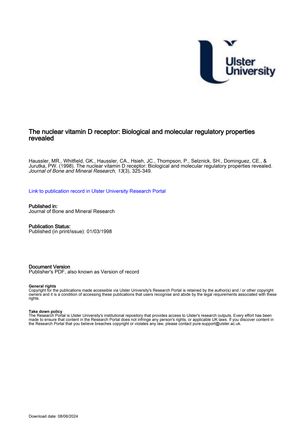The Nuclear Vitamin D Receptor: Biological and Molecular Regulatory Properties Revealed
March 1998
in “
Journal of bone and mineral research
”
vitamin D receptor VDR gene expression regulation calcium homeostasis phosphate homeostasis bone mineralization immune system neural system hair development skin development VDR knockout mice hereditary hypocalcemic vitamin D–resistant rickets HVDRR alopecia bone mineralization defects vitamin D metabolism VDR mutations vitamin D endocrine system therapeutic target vitamin D receptor VDR hair loss skin health alopecia bone health vitamin D system

TLDR The vitamin D receptor is crucial for bone health and affects various body systems, with mutations potentially leading to disease.
The document from 1998 reviewed the role of the vitamin D receptor (VDR) in gene expression regulation and its importance in calcium and phosphate homeostasis, necessary for bone mineralization. It discussed VDR's involvement in various bodily systems, including immune and neural systems, and its necessity for hair and skin development, as evidenced by the phenotype of VDR knockout mice. These mice displayed symptoms similar to hereditary hypocalcemic vitamin D–resistant rickets (HVDRR), such as alopecia and bone mineralization defects. The review also addressed the feedback regulation of vitamin D metabolism by the VDR and the implications of VDR mutations in human diseases. The document emphasized VDR's significance in the vitamin D endocrine system and its potential as a therapeutic target.



